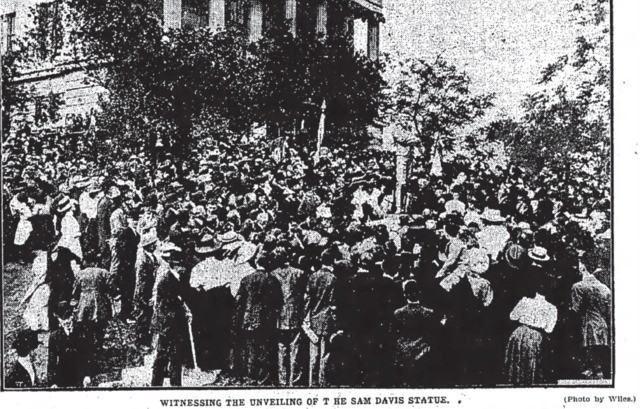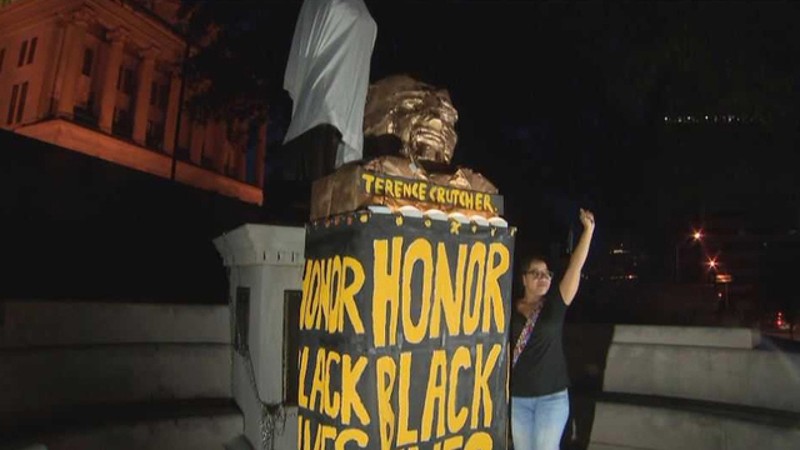Sam Davis Statue
Introduction
Text-to-speech Audio
Images
Crowded Unvealing of Sam Davis Statue with Flowers on Base (1909)

The crowd gathered for the unveiling of the Sam Davis statue (1909)

The "Boy Hero of the Confederacy" with Tennessee State Capitol , Nashville, on The Background (2006)

Close Up Picture of the Sam Davis Statue on a Sunny Summer Day

Close Up Picture of the Sam Davis Statue From a Visitors Angle on a Clear Day on the Spring with Tennessee State Capitol on The Background

Sam Davis Monument Covered by "Black Lives Matter" Protesters (2017)

Sam Davis Monument Being Covered by Allegedly "Black Lives Matter" Protesters with Facemasks (2020)

Backstory and Context
Text-to-speech Audio
The Boy Hero of the Confederacy, Sam Davis, had been dead for over 40 years before he procured a genuinely fearless figure. Pulaski, the city where Davis was hanging, built it in 1906, an impeccable marble of a supposedly Italian expert. It remains in a position of pride at the town hall grass, on a vainglorious 15-foot high platform. His arms appear to be built purposely with a disobedient and defiant reason and he looks a lot more youthful than the sculpture of Sam Davis raised three years after the fact on Tennessee State Capitol's property in Nashville.
The Daughters of the Confederacy detailed gathering 4,000 dollars for the landmark in a February 1908 article in Tennessee. It is critical to comprehend that because of inflation, this $4000 represents a higher buying power than it does these days. As indicated by the Bureau of Labor Statistics purchaser value record, the present costs in 2020 are 2,730.30% higher than normal costs since 1908. The U.S. dollar encountered a normal expansion pace of 3.03% every year during this period, making the genuine estimation of a dollar decline. As such, $4,000 in 1908 is equivalent in purchasing power to about $113,212.17 in 2020. The Tennessean reported on April 30, 1909, the day after the sculpture was dedicated to Sam Davis, the commitments for the landmark came from each State in the Union." The bronze sculpture with a marble base from Tennessee was revealed as "dixie" was performing with a crowd of around 5,000 individuals gathered. The sculpture took around 8 years from the day the funds became to be collected to the day it was completed, as indicated by articles in both The Tennessean and The Columbia Herald.
Sam Davis (October 6, 1842 – November 27, 1863) lived in the period of the Civil War, a conflict that from 1861 until 1865 put in opposite sides the north and the south of the United States of America. The colonists occupied the north to set residency, while the south has a colonial system based on the exploitation of slavery work, already extinct in the north. With the advancement Industrial Revolution, restrictions on slavery became increasingly strong, however, the large farmers in the south refused to give up their cheap source of labor.
The north/south division and slave states/free states became increasingly polarized in all parts of society, leading to political debate: which way should the United States follow, the south of the slavery, or the cosmopolitan and industrial north? The issue would only be resolved by weapons.
In Tennessee, Davis’ family plantation had more than fifty slaves. He entered the 1st Tennessee Infantry in 1861. Sam Davis was trusted with the mission of delivering strategic information. He was captured While heading to his destination in possession of newspapers and detailed drawings of Union fortifications at Nashville and other towns in Middle Tennessee. He was imprisoned in Pulaski under command of General Grenville M. Dodge and accused of espionage.
Tennessee played a key role throughout the history of this civil war. Armies were basically destroying most of the very fertile land that this state possessed. They were also the last state to secede from the union. Tennessee was the state that contributed the most troops to Lincoln’s request for an army. On top of all those reasons, many significant battles took place along the Cumberland and Tennessee rivers because of their strategic positioning for the transportation of supplies. Davis was found guilty condemned to the gallows. However, before executing him, general Dodge offered to spare his life in exchange for confidential information to which Davis replied: "I had rather die a thousand deaths." He was hung on November 27, 1863.
Because of his heroic act and loyalty to his cause, Davis is considered for many as a hero of the American Civil War. Several landmarks areas of middle Tennessee have representations of his life and death. One can be found in front of the Montgomery Bell Academy, then known as the Western Military Institute. The place of his execution, as well as the court square in Pulaski, have statues of Davis. The most prominent life-size statue of Sam Davis is located prominently on the southeast corner of the state capitol grounds in Nashville. Artifacts that belonged to Davis, such as the overcoat worn at the time of his arrest and the boot in which papers were concealed, are displayed for exhibition at the Tennessee State Museum. The Sam Davis Memorial Association, a non-profit organization maintains a house outside Smyrna, which is visited by thousands of peoples every year. Davis was posthumously honored by the sons of the confederate veterans with a Medal of Honor in 1977.
Because of how young Sam Davis died, the way he was executed, and the reasons it occurred, his memorial on the site of the State capital of Tennessee carried none of the complaints and manifestations of recent threatened Confederate monuments. Nevertheless, in 1999, a memorial to the victims of enslavement was raised by the Black Caucus of Tennessee State legislatures near the statue of Davis. This statue has gradually become more controversial with time. During the year 2020, during the “Black Lives Matter” protests, after the assassination of George Floyd, many confederate-related monuments have been targeting because of its association with slavery. The Sam Davis statue was not turned down and was covered by protesters during this time. Similarly, another Sam Davis statue, which was located on the Montgomery Bell Academy, was removed because of its association with racism and slavery.
Sources
Bailey, Heather. “‘Recovering Their Story: African Americans on the Davis Plantation, 1850-1925.’ Sam Davis Home, Smyrna, Tenn.” Journal of American History 94, no. 3 (December 2007): 891–94. doi:10.2307/25095153.
Harber, Susan. “Harber: Sam Davis Remains Most Admired for His Courage.” The Daily News Journal. Murfreesboro, July 18, 2015.https://www.dnj.com/story/news/2015/07/17/harber-sam-davis-remains-admired-courage/30333273/.
“History of Enslaved Workers at the Davis Plantation.” The Historic Sam Davis Home and Plantation: A Nonprofit Organization. Accessed October 4, 2020. https://www.samdavishome.org/history-of-enslaved-workers-at-the-davis-plantation. \
“Memorialized: Sam Davis, Boy Hero.” America’s Civil War 20, no. 6 (January 2008): 14. https://search-ebscohost-com.ezproxy.stvincent.edu/login.aspx?direct=true&db=aph&AN=27365948&site=ehost-live.
Press, Associated. “Confederate Soldiers Have Their Own Medal of Honor.” The News Leader. STA, April 26, 2014. https://www.newsleader.com/story/news/local/2014/04/26/confederate-soldiers-have-their-own-medal-of-honor/8205749/.
“Sam Davis.” TN History for Kids. Accessed October 4, 2020. http://www.tnhistoryforkids.org/history/people/people/sam-davis.2443066
“Sam Davis: Boy Hero.” The Historic Sam Davis Home and Plantation: A Nonprofit Organization. Accessed October 1, 2020. https://www.samdavishome.org/sam-davis-boy-hero.
“Slave's Story Disclosed at Sam Davis Home,” February 5, 2014. https://www.cannoncourier.com/slaves-story-disclosed-at-sam-davis-home-cms-11892.
https://www.murfreesboropost.com/community/why-does-the-legend-of-sam-davis-endure/article_9918a002-6727-5238-aff9-472326afcb23.html
https://www.nashvillescene.com/news/pith-in-the-wind/article/20973119/its-time-to-put-the-boy-hero-of-the-confederacy-to-bed
https://en.wikipedia.org/wiki/Sam_Davis_Statue#/media/File:Sam_Davis_Statue.jpg
https://www.dnj.com/story/news/local/2020/07/30/sam-davis-confederate-monument-nashville-smyrna-home/5364067002/
https://mapio.net/pic/p-10480810/
https://www.newschannel5.com/news/protesters-cover-sam-davis-monument-at-state-capitol
https://www.dnj.com/story/news/local/2020/07/30/sam-davis-confederate-monument-nashville-smyrna-home/5364067002/
